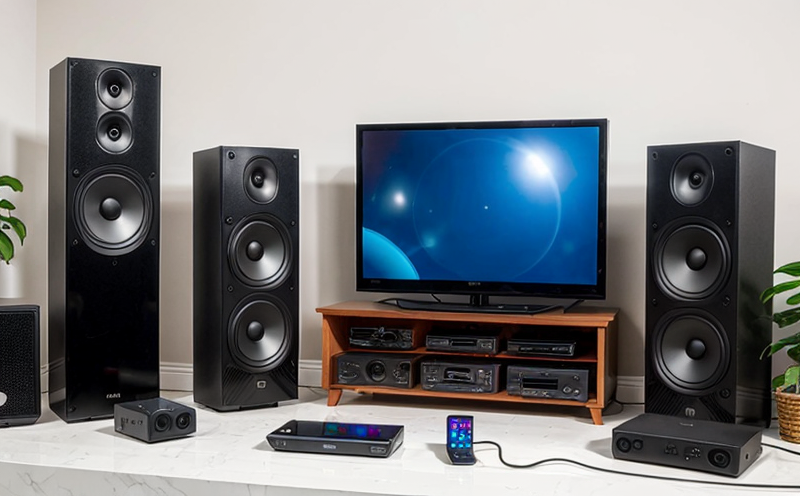RTCA DO 160 Section 21 Emission Testing for Portable AV Equipment
The RTCA/DO-160D is a comprehensive standard developed by the Radio Technical Commission for Aeronautics to ensure that electronic equipment used in aviation environments meets strict electromagnetic interference (EMI) and radio frequency radiation requirements. Section 21 specifically addresses emissions testing, which is critical for portable audio visual (AV) devices like headsets, speakers, and video players intended for use in aircraft cabins.
The objective of this section is to ensure that the emissions from these devices do not interfere with onboard communication systems or other electronic equipment. Emissions can be conducted from various sources such as power supplies, circuit boards, or even the device housing itself. The standard specifies test procedures and acceptance criteria for ensuring compliance with emission limits.
Compliance with RTCA/DO-160D Section 21 is mandatory for manufacturers of portable AV equipment that are intended to be used in commercial aircraft. This includes headsets, speakers, video players, and other similar devices that might interfere with the operation of aircraft systems. The testing process involves a series of steps aimed at identifying and quantifying emissions from all parts of the device.
The first step is to conduct preliminary screening tests which involve measuring the emission levels in an unshielded environment. This helps identify any components or design features that may be problematic. If initial results suggest non-compliance, further testing is required using a controlled chamber designed to simulate the aircraft cabin environment. The chamber can replicate various conditions such as humidity levels, temperature ranges, and even altitude pressures.
Once conducted in this more stringent environment, final measurements are made to ensure that emissions fall within acceptable limits. Compliance with these standards ensures not only functional integrity but also passenger safety by preventing interference with critical communications systems onboard the aircraft. For manufacturers looking to enter the aviation market, achieving compliance can significantly enhance their product’s credibility and appeal.
Compliance involves a thorough understanding of both theoretical aspects and practical implementation details. It requires careful design considerations during the early stages of development to minimize potential issues later on. Additionally, rigorous testing protocols must be followed meticulously throughout each stage of production to maintain consistent quality standards.
The complexity and importance of compliance cannot be overstated given its impact on both operational efficiency and passenger safety within aviation environments. Manufacturers who fail to meet these stringent requirements risk not only delays in certification but also potential recalls or even legal actions. Therefore, investing in specialized testing facilities equipped with state-of-the-art equipment is essential for ensuring accurate and reliable results.
In summary, RTCA/DO-160D Section 21 emission testing ensures that portable AV devices used in aircraft cabins meet strict electromagnetic interference (EMI) and radio frequency radiation standards. By following the specified procedures rigorously, manufacturers can guarantee their products’ compliance with these critical safety requirements while enhancing overall passenger comfort and satisfaction.
Why It Matters
The importance of RTCA/DO-160D Section 21 emission testing for portable AV equipment cannot be overstated. Compliance ensures that the devices do not emit excessive levels of electromagnetic interference (EMI) or radio frequency radiation, which could potentially disrupt critical communication systems on board aircraft.
- It protects against interference with avionics and other sensitive electronics.
- Ensures consistent performance across different environmental conditions typical of commercial flights.
- Promotes passenger safety by minimizing risks associated with electromagnetic disturbances in enclosed spaces like aircraft cabins.
- Facilitates smooth operations for flight crews, ensuring reliable communication channels remain unimpeded.
The standards set forth in RTCA/DO-160D Section 21 are designed to mitigate these potential hazards effectively. By adhering strictly to the prescribed testing methods and criteria outlined within this section, manufacturers can demonstrate their commitment to maintaining high levels of quality control throughout the manufacturing process.
Applied Standards
The primary standard applied during RTCA/DO-160D Section 21 emission testing for portable AV equipment is the RTCA/DO-160D document itself. This regulatory guideline provides detailed instructions on how to conduct emissions tests, including both general requirements and specific procedures tailored to various types of electronic devices.
Other relevant standards that may be referenced include those from international bodies such as ISO (International Organization for Standardization), ASTM (American Society for Testing and Materials), and IEC (International Electrotechnical Commission). These organizations contribute additional guidance on related topics like electromagnetic compatibility, interference control techniques, and measurement methodologies.
Manufacturers must ensure their products meet all applicable standards at every stage of development. This includes conducting thorough pre-production testing followed by rigorous quality assurance checks during manufacturing processes. By doing so, they can confidently claim compliance with not just RTCA/DO-160D but also broader industry best practices.
Failure to comply with these standards could result in delays or even prevent the successful certification of a product line. Therefore, it is crucial for manufacturers to invest time and resources into understanding and implementing all necessary testing procedures correctly.
Industry Applications
- Airline companies looking to integrate new audiovisual equipment into their fleets.
- Aviation manufacturers developing passenger entertainment systems.
- Original Equipment Manufacturers (OEMs) producing portable AV devices designed specifically for use on commercial aircraft.
- Pilots and crew members who need reliable communication tools free from interference during critical moments.
In addition to these direct applications, compliance with RTCA/DO-160D Section 21 also benefits industries beyond aviation. For example, manufacturers of medical devices operating in confined spaces may find value in adopting similar practices to ensure minimal EMI impact on surrounding equipment.





